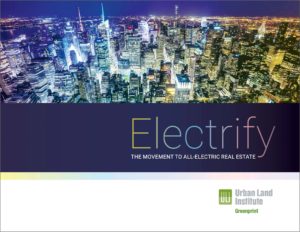On the retrofit side, a 10-year payback on the electrification of floor space is achievable in the 27 percent of U.S. commercial buildings currently heating with fossil fuels, the report states. If there is a downside to this solution, it comes in the mismatch with most investors’ hold strategies, which typically run short of the 10-year mark.
With cities’ increasing movement toward carbon-zero targets, ULI states that electrification can provide building alignment with those goals, and test cases are already in place. “The Building Electrification Institute is helping 11 cities, such as San Jose [in California]; Salt Lake City; and Boston pilot strategies to scale up the electrification of building heating and cooling systems in a way that supports local market development, regional partnerships and an equitable transition.”

It is also an effective interface with the electric grid, both current power distribution systems and those of the smart variety, since “communicating with the utility grid to support demand response, and actively managing peak loads are all strategies electric buildings can incorporate to further reduce energy costs and optimize efficiencies.”
Not surprisingly, there are barriers, beyond first costs for retrofits, that can prevent electrification from being an across-the-board solution. These include conflicting building codes and utility infrastructure.
There is also a social justice component to consider. “Because of the upfront costs of retrofitting
existing assets to all-electric, targeted investment and empowered communities are needed to support an equitable transition,” the report explains. Taking a hopeful stance, ULI states that, “many companies and stakeholders are already identifying strategies to overcome these hurdles.”
As we have seen with smart technologies, we are now just on the threshold of all-electric as a widespread viability. But the is future filled with promise.
To read more about trends in sustainability, technology, connectivity and more in a post-pandemic commercial real estate industry, check out BOMA International’s July 2021 Deep Dive, The Office Building’s Role in the Optimized City of the Future, at www.boma.org/DeepDives.
ABOUT THE AUTHOR
John Salustri is editor-in-chief of Salustri Content Solutions, a national editorial advisory firm based in East Northport, New York. He is best known as the founding editor of GlobeSt.com. Prior to launching GlobeSt.com, Salustri was editor of Real Estate Forum.